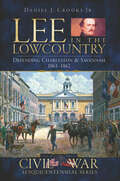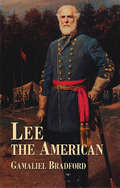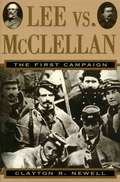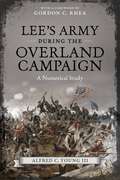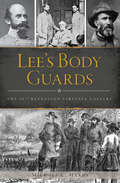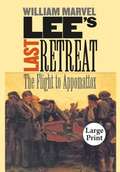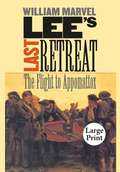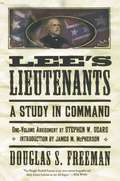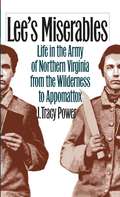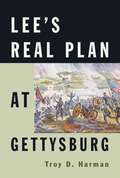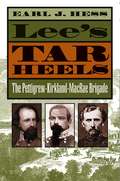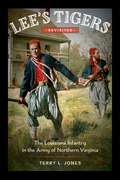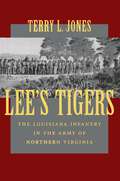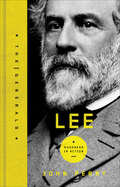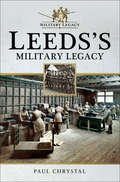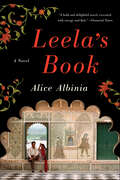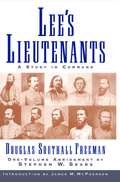- Table View
- List View
Lee de Forest
by Mike AdamsThe life-long inventor, Lee de Forest invented the three-element vacuum tube used between 1906 and 1916 as a detector, amplifier, and oscillator of radio waves. Beginning in 1918 he began to develop a light valve, a device for writing and reading sound using light patterns. While he received many patents for his process, he was initially ignored by the film industry. In order to promote and demonstrate his process he made several hundred sound short films, he rented space for their showing; he sold the tickets and did the publicity to gain audiences for his invention. Lee de Forest officially brought sound to film in 1919. Lee De Forest: King of Radio, Television, and Film is about both invention and early film making; de Forest as the scientist and producer, director, and writer of the content. This book tells the story of de Forest's contribution in changing the history of film through the incorporation of sound. The text includes primary source historical material, U.S. patents and richly-illustrated photos of Lee de Forest's experiments. Readers will greatly benefit from an understanding of the transition from silent to audio motion pictures, the impact this had on the scientific community and the popular culture, as well as the economics of the entertainment industry.
Lee in the Lowcountry: Defending Charleston & Savannah 1861–1862 (Civil War Ser.)
by Daniel J. Crooks Jr.This Civil War biography sheds light on the Confederate General&’s first year serving the newly formed Southern Republic. Early in the Civil War, General Robert E. Lee was given command of the Department of South Carolina, Georgia and East Florida. Making him, in effect, the first line of defense for for Confederacy and two of its key cities: Charleston and Savannah. In Lee in the Lowcountry, Charleston historian Danny Crooks examines this period in Lee&’s career, in which he faced with confusion and convoluted loyalty among the ranks. Using Lee&’s own words and those of his contemporaries, Crooks helps the reader to understand why Lee, and only Lee, could bring order to the early chaos of the war. He also reveals how Lee acquired the two most famous trademarks of his wartime career while in the Lowcountry. Long hours in the saddle prompted Lee to grow his signature beard and, while at Pocotaligo, he acquired his beloved equine companion, Traveller.
Lee the American (Civil War)
by Gamaliel BradfordSympathetic portrait of an enigmatic man who was a model of decorum and honor, a moderate on the issue of secession, a fierce fighter in battle, and a chivalrous soldier — even in defeat. Exceptional sourcebook for students of American history, Civil War buffs, and admirers of the Southern general. 10 black-and-white illustrations.
Lee vs. McClellan: The First Campaign
by Clayton R. NewellIn 1861, two brilliant but inexperienced generals faced off in the rugged mountains of western Virginia. Neither Robert E. Lee nor George B. McClellan had ever commanded an army before; but in the crucial first campaign of the bloody Civil War, both men were quickly put to the test. Lee vs. McClellan is a vivid, gripping account of this often-overlooked first campaign--a campaign that taught both North and South the grueling realities of war.
Lee's Army during the Overland Campaign: A Numerical Study
by Alfred C. Young III Gordon. C RheaThe initial confrontation between Union general Ulysses S. Grant and Confederate general Robert E. Lee in Virginia during the Overland Campaign included the pivotal battles of Wilderness, Spotsylvania, and Cold Harbor. Yet this crucial engagement has only recently received the same degree of scrutiny as other Civil War battles. In Lee's Army during the Overland Campaign, Alfred C. Young III makes a significant contribution to that study by providing for the first time accurate information regarding the Confederate side throughout the conflict. While the strength and casualties in Grant's army remain uncontested, historians know much less about Lee's army because of poor record keeping by the Confederates as well as an inordinate number of missing or lost battle reports. The complexity of the Overland Campaign, which consisted of several smaller engagements in addition to the three main clashes, led to considerable historic uncertainty regarding Lee's army. Significant doubts persist about the army's capability at the commencement of the drive, the amount of reinforcements received, and the total of casualties sustained during the entire campaign and at each of the major battles. The prevailing narrative depicts Confederates as outstripped nearly two to one and portrays Grant suffering losses at a rate nearly double that of Lee. Many Civil War scholars contend that the campaign proved a clear numerical victory for Lee but a tactical triumph for Grant. Young's decade of research, however, contests that notion with new statistical data. Through thorough analysis of information compiled from the National Archives and personal estates Young challenges common assumptions about the Overland Campaign, showing clearly that Lee's army stood far larger in strength and size and suffered much higher casualties than previously believed.
Lee's Body Guards: The 39th Battalion Virginia Cavalry (Civil War Ser.)
by Michael C HardyThey considered themselves "Lee's Body Guard," cavalrymen specifically recruited to serve as scouts, couriers and guides for General Robert E. Lee. Though their battle experiences might pale compared to those of soldiers under J.E.B. Stuart and Wade Hampton, the men of the 39th Virginia served crucial roles in the Confederate army. From the fields of Second Manassas to Appomattox Court House, they were privy to the inner workings of the Confederate high command. They were also firsthand witnesses to the army's victories and triumphs and to its tragedies and trials, from losing Stonewall Jackson at Chancellorsville to losing the opportunity to win the war at Gettysburg. Award-winning author Michael C. Hardy chronicles the experiences of this unique group of Confederate cavalrymen.
Lee's Last Campaign: The Story of Lee and His Men Against Grant-1864
by Clifford DowdeyBy May 1864, General Robert E. Lee had been transformed from a young soldier into a gray-haired patriarch of the Confederate cause. As Lee struggled to keep his ragged soldiers alive, he faced pressure from two fronts. Grant’s Union Army not only had superior numbers, but a steadfast infra-structure or railroads and industrialized supply routes. Lee’s Last Campaign is a triumph of historic research and elegant writing. In this essential analysis of General Lee’s military strategy, Dowdey follows the triumphs and tragedies of the Army of Northern Virginia as it breathed its last gasps at the end of the Civil War.
Lee's Last Retreat: The Flight to Appomattox
by William MarvelFew events in Civil War history have generated such deliberate mythmaking as the retreat that ended at Appomattox. William Marvel offers the first history of the Appomattox campaign written primarily from contemporary source material, with a skeptical eye toward memoirs published well after the events they purport to describe. Marvel shows that during the final week of the war in Virginia, Lee's troops were more numerous yet far less faithful to their cause than has been suggested. He also proves accounts of the congenial intermingling of the armies at Appomattox to be shamelessly overblown and the renowned exchange of salutes to be apocryphal.
Lee's Lieutenants Third Volume Abridged: A Study in Command
by Douglas Southall FreemanLee's Lieutenants: A Study in Command is the most colorful and popular of Douglas Southall Freeman's works. A sweeping narrative that presents a multiple biography against the flame-shot background of the American Civil War, it is the story of the great figures of the Army of Northern Virginia who fought under Robert E. Lee.The Confederacy won resounding victories throughout the war, but seldom easily or without tremendous casualties. Death was always on the heels of fame, but the men who commanded -- among them Jackson, Longstreet, and Ewell -- developed as leaders and men. Lee's Lieutenants follows these men to the costly battle at Gettysburg, through the deepening twilight of the South's declining military might, and finally to the collapse of Lee's command and his formal surrender in 1865. To his unparalleled descriptions of men and operations, Dr. Freeman adds an insightful analysis of the lessons learned and their bearing upon the future military development of the nation. Accessible at last in a one-volume edition abridged by noted Civil War historian Stephen W. Sears, Lee's Lieutenants is essential reading for all Civil War buffs, students of war, and admirers of the historian's art as practiced at its very highest level.
Lee's Lieutenants: A Study in Command (Lee's Lieutenants: A Study In Command Ser. #3)
by Douglas Southall FreemanLee's Lieutenants: A Study in Command is the most colorful and popular of Douglas Southall Freeman's works. A sweeping narrative that presents a multiple biography against the flame-shot background of the American Civil War, it is the story of the great figures of the Army of Northern Virginia who fought under Robert E. Lee.The Confederacy won resounding victories throughout the war, but seldom easily or without tremendous casualties. Death was always on the heels of fame, but the men who commanded—among them Jackson, Longstreet, and Ewell—developed as leaders and men. Lee's Lieutenants follows these men to the costly battle at Gettysburg, through the deepening twilight of the South's declining military might, and finally to the collapse of Lee's command and his formal surrender in 1865. To his unparalleled descriptions of men and operations, Dr. Freeman adds an insightful analysis of the lessons learned and their bearing upon the future military development of the nation. Accessible at last in a one-volume edition abridged by noted Civil War historian Stephen W. Sears, Lee's Lieutenants is essential reading for all Civil War buffs, students of war, and admirers of the historian's art as practiced at its very highest level.
Lee's Miserables
by J. Tracy PowerNever did so large a proportion of the American population leave home for an extended period and produce such a detailed record of its experiences in the form of correspondence, diaries, and other papers as during the Civil War. Based on research in more than 1,200 wartime letters and diaries by more than 400 Confederate officers and enlisted men, this book offers a compelling social history of Robert E. Lee's Army of Northern Virginia during its final year, from May 1864 to April 1865. Organized in a chronological framework, the book uses the words of the soldiers themselves to provide a view of the army's experiences in camp, on the march, in combat, and under siege--from the battles in the Wilderness to the final retreat to Appomattox. It sheds new light on such questions as the state of morale in the army, the causes of desertion, ties between the army and the home front, the debate over arming black men in the Confederacy, and the causes of Confederate defeat. Remarkablyrich and detailed, Lee's Miserables offers a fresh look at one of the most-studied Civil War armies. "A landmark book. . . . When the end came, the men of the Army of Northern Virginia passed into legend. Power's important study brings a large measure of reality back to their story.--Edward D. C. Campbell, Jr., American History"Power's research is voluminous and his conclusions sensible and thought-provoking. The result is a major and welcome addition to the literature of how armies are made and how they die.--Steven E. Woodworth, Blue & Gray Education Society Newsletter"A classic Civil War study--immensely useful to the historian, vigorous and enlightening to the common reader. It is a glimpse into the American soul: what is best and worst about us, our riches and griefs, discontents, yearnings, murderous urges, and abiding faith.--Donald McCaig, Washington Post Book World"One of the finest works ever written on the Army of Northern Virginia.--Keith Bohannon, Civil War HistoryBased on research in more than 1,200 wartime letters and diaries by more than 400 Confederate officers and enlisted men, Lee's Miserables offers a compelling social history of Robert E. Lee's Army of Northern Virginia during its final year, from May 1864 to April 1865. The book uses the words of the soldiers themselves to provide a richly detailed view of the army's experiences in camp, on the march, in combat, and under siege--from the battles in the Wilderness to the final retreat to Appomattox. -->
Lee's Real Plan at Gettysburg
by Troy D. HarmanFor almost 100 years, analysis of the Gettysburg Campaign has centered around an oversimplified view of Confederate general Robert E. Lee's goals for the battle. Lee's Real Plan at Gettysburg presents a provocative new theory regarding Lee's true tactical objectives during this pivotal battle of the American Civil War.
Lee's Tar Heels
by Earl J. HessThe Pettigrew-Kirkland-MacRae Brigade was one of North Carolina's best-known and most successful units during the Civil War. Formed in 1862, the brigade spent nearly a year protecting supply lines before being thrust into its first major combat at Gettysburg. There, James Johnston Pettigrew's men pushed back the Union's famed Iron Brigade in vicious fighting on July 1 and played a key role in Pickett's Charge on July 3, in the process earning a reputation as one of the hardest-fighting units in Robert E. Lee's Army of Northern Virginia. Despite suffering heavy losses during the Gettysburg campaign, the brigade went on to prove its valor in a host of other engagements. It marched with Lee to Appomattox and was among the last Confederate units to lay down arms in the surrender ceremony.Earl Hess tells the story of the men of the Pettigrew-Kirkland-MacRae Brigade, and especially the famous 26th North Carolina, chronicling the brigade's formation and growth under Pettigrew and its subsequent exploits under William W. Kirkland and William MacRae. Beyond recounting the brigade's military engagements, Hess draws on letters, diaries, memoirs, and service records to explore the camp life, medical care, social backgrounds, and political attitudes of these gallant Tar Heels. He also addresses the continuing debate between North Carolinians and Virginians over the failure of Pickett's Charge.
Lee's Tigers Revisited: The Louisiana Infantry in the Army of Northern Virginia
by Terry L. JonesIn Lee’s Tigers Revisited, noted Civil War scholar Terry L. Jones dramatically expands and revises his acclaimed history of the approximately twelve thousand Louisiana infantrymen who fought in Robert E. Lee’s Army of Northern Virginia. Sometimes derided as the “wharf rats from New Orleans” and the “lowest scrappings of the Mississippi,” the Louisiana Tigers earned a reputation for being drunken and riotous in camp, but courageous and dependable on the battlefield. Louisiana’s soldiers, some of whom wore colorful uniforms in the style of French Zouaves, reflected the state’s multicultural society, with regiments consisting of French-speaking Creoles and European immigrants. Units made pivotal contributions to many crucial battles—resisting the initial Union onslaught at First Manassas, facilitating Stonewall Jackson’s famous Valley Campaign, holding the line at Second Manassas by throwing rocks when they ran out of ammunition, breaking the Union line temporarily at Gettysburg’s Cemetery Hill, containing the Union breakthrough at Spotsylvania’s Bloody Angle, and leading Lee’s attempted breakout of Petersburg at Fort Stedman. The Tigers achieved equal notoriety for their outrageous behavior off the battlefield, so much so that sources suggest no general wanted them in his command. By the time of Lee’s surrender at Appomattox, there were fewer than four hundred Louisiana Tigers still among his troops. Lee’s Tigers Revisited uses letters, diaries, memoirs, newspaper articles, and muster rolls to provide a detailed account of the origins, enrollments, casualties, and desertion rates of these soldiers. Illustrations—including several maps newly commissioned for this edition—chart the Tigers’ positions on key battlefields in the tumultuous campaigns throughout Virginia. By utilizing first-person accounts and official records, Jones provides the definitive study of the Louisiana Tigers and their harrowing experiences in the Civil War.
Lee's Tigers: The Louisiana Infantry in the Army of Northern Virginia
by Terry L. JonesSometimes called the "wharf rats from New Orleans" and the "lowest scrapings of the Mississippi," Lee's Tigers were the approximately twelve thousand Louisiana infantrymen who served in the Confederate Army of Northern Virginia from the time of the campaign at First Manassas to the final days of the war at Appomattox. Terry L. Jones offers a colorful, highly readable account of this notorious group of soldiers renowned not only for their drunkenness and disorderly behavior in camp but for their bravery in battle. It was this infantry that held back the initial Federal onslaught at First Manassas, made possible General Stonewall Jackson's famed Valley Campaign, contained the Union breakthrough at Spotsylvania's Bloody Angle, and led Lee's last offensive actions at Fort Stedman and Appomattox.Despite all their vices, Lee's Tigers emerged from the Civil War with one of the most respected military records of any group of southern soldiers. According to Jones, the unsavory reputation of the Tigers was well earned, for Louisiana probably had a higher percentage of criminals, drunkards, and deserters in its commands than any other Confederate state. The author spices his narrative with well-chosen anecdotes-among them an account of one of the stormiest train rides in military history. While on their way to Virginia, the enlisted men of Coppens' Battalion uncoupled their officers' car from the rest of the train and proceeded to partake of their favorite beverages. Upon arriving in Montgomery, the battalion embarked upon a drunken spree of harassment, vandalism, and robbery. Meanwhile, having commandeered another locomotive, the officers arrived and sprang from their train with drawn revolvers to put a stop to the disorder. "The charge of the Light Brigade," one witness recalled, "was surpassed by these irate Creoles."Lee's Tigers is the first study to utilize letters, diaries, and muster rolls to provide a detailed account of the origins, enrollments, casualties, and desertion rates of these soldiers. Jones supplies the first major work to focus solely on Louisiana's infantry in Lee's army throughout the course of the war. Civil War buffs and scholars alike will find Lee's Tigers a valuable addition to their libraries.
Lee: Goodness in Action (The Generals Series)
by John PerryA biography of the often misunderstood, yet heroic, Confederate general who sacrificed everything for his native state of Virginia during the Civil War. Traitor. Divider. Defender of slavery. This damning portrayal of Robert E. Lee has persisted through 150 years of history books. And yet it has no basis in fact.In the spirit of bold restoration, Lee: A Life of Virtue reveals the true Lee—passionate patriot, caring son, devoted husband, doting father, don’t-tread-on-me Virginian, Godfearing Christian.Weaving forgotten facts and revelations (Lee considered slavery a moral outrage) with striking personal details (for years he carried his weakened mother to and from her carriage), biographer John Perry crafts a compelling treatment of the virtuous warrior who endured withering opposition and sacrificed all to stand for Constitutional freedoms.
Lee: The Last Years
by Charles Bracelen FloodA New York Times bestselling author&’s revealing account of General Robert E. Lee&’s life after Appomattox: &“An American classic" (Atlanta Journal-Constitution). After his surrender at Appomattox in 1865, Robert E. Lee, commanding general for the Confederate Army of Northern Virginia during the Civil War, lived only five more years. It was the great forgotten chapter of his remarkable life, during which Lee did more to bridge the divide between the North and the South than any other American. The South may have lost, but Lee taught them how to triumph in peace, and showed the entire country how to heal the wounds of war. Based on previously unseen documents, letters, family papers and exhaustive research into Lee&’s complex private life and public crusades, this is a portrait of a true icon of Reconstruction and quiet rebellion. From Lee&’s urging of Rebel soldiers to restore their citizenship, to his taking communion with a freedman, to his bold dance with a Yankee belle at a Southern ball, to his outspoken regret of his soldierly past, to withstanding charges of treason, Lee embodied his adage: &“True patriotism sometimes requires of men to act exactly contrary, at one period, to that which it does at another.&” Lee: The Last Years sheds a vital new light on war, politics, hero-worship, human rights, and Robert E. Lee&’s &“desire to do right.&”
Leeches, Maggots, and Skulls: Curious Cures from History (Fountas & Pinnell Classroom, Guided Reading)
by Dave Smith Lynda JonesNIMAC-sourced textbook. EW! Imagine eating bedbugs to cure a cold. Or swallowing leeches to heal your swollen tonsils. History is full of odd cures like these. Travel back in time to learn about the sometimes-horrid history of healing.
Leeds Rifles: The Prince of Wales's Own (West Yorkshire Regiment) 7th and 8th Territorial Battalions 1914–1918: Written in Letters of Gold
by Andrew J. KirkThe first detailed chronicle, with photos included, of the four battalions of riflemen who left Leeds for the Western Front. The full wartime story of the &“Leeds Pals&” has never been told. This volume describes their volunteer origins and how they came to be woven into the social fabric of Leeds from where they drew their enduring esprit de corps, discipline, and resolve. It takes the reader on a journey across the Western Front of the Great War, contrasting the first line battalion&’s lot, to stand in the mud of Ypres and endure all without breaking, with the second line battalion&’s blooding at Bullecourt and transformation as part of an elite assault division that went on to occupy Germany. It is told, in part, by those who were there and experienced the fear, elation, and sadness of loss, and who took strength from their volunteer ethos and their common origins in Leeds. All the Leeds Rifles&’ main battles are described in detail as are the helter-skelter actions of the last one hundred days of mobile warfare and escalating casualties, when the defeated but still defiant German army found itself in full and final retreat. Follow the fortunes of these enfants de Yorkshire, these Leeds Lads, as they speak out from the pages of history with a very familiar accent.
Leeds at War, 1939–45 (Your Towns & Cities in World War Two)
by Stephen WadeLeeds at War 1939-1945 is a comprehensive account of the city's experience of the war, covering in expert detail life on the Home Front set against the background of the wider theaters of war.The narrative of that global conflict is given with a focus on the trials and ordeals that faced the people of Leeds as they cheered their men and women fighters off to war, were bombed and saw their children evacuated to rural areas.Rare insights into the life of war-torn Leeds are included, along with untold stories from the footnotes of that history, from the air-raid shelters to the internment issues. The book incorporates the unique human record of that struggle from memoirs and memories, so that the reader sees the war bottom up from the ordinary people, although the military experiences of Leeds' citizens are not ignored.More controversial topics are also touched upon, such as anti-Semitism, labor troubles and crime, to give a full and fascinating picture of a great city facing profound trials of endurance, courage, and that true Yorkshire grit that has been the hallmark of the city's rise to prominence in Britain.
Leeds's Military Legacy (Military Legacy)
by Paul ChrystalLeedss Military Legacy is the first fully illustrated book to give a comprehensive description of the military history of Leeds from Roman, Anglo-Saxon and Norman times to the present as home to various garrisons and military museums, not least the renowned Leeds Armouries Museum. Along the way it describes Royalist Leeds and the Civil War, the formation of various regiments in the city between the seventeenth and twenty-first centuries, the impact of two World Wars and how the city rose to the challenges of recruitment, defense and industrial war effort. The battle honors of each of the Leeds regiments are detailed as are the VCs. The book also covers the work of the Leeds military hospitals, the Barnbow Munitions disaster, RAF Yeadon (LeedsBradford Airport), the blitz of 1941, 609 Squadron, Yeadon Lancaster factory, Leeds as a garrison city and current military research in Leeds.
Leela's Book: A Novel
by Alice Albinia"Steeped in the tradition of the Indian epic, yet modern and vastly entertaining." —The Times (London)In her fiction debut, Alice Albinia weaves a multithreaded epic tale that encompasses divine saga and familial discord and introduces an unforgettable heroine. Leela—alluring, taciturn, haunted—is moving from New York back to Delhi. Worldly and accomplished, she has been in self-imposed exile from India and her family for decades; twenty-two years earlier, her sister was seduced by the egotistical Vyasa, and the fallout from their relationship drove Leela away. Now an eminent Sanskrit scholar, Vyasa is preparing for his son’s marriage. But when Leela arrives for the wedding, she disrupts the careful choreography of the weekend, with its myriad attendees and their conflicting desires.Gleefully presiding over the drama is Ganesh—divine, elephant-headed scribe of the Mahabharata, India’s great epic. The family may think they have arranged the wedding for their own selfish ends, but according to Ganesh it is he who is directing events—in a bid to save Leela, his beloved heroine, from Vyasa. As the weekend progresses, secret online personas, maternal identities, and poetic authorships are all revealed; boundaries both religious and continental are crossed; and families are ripped apart and brought back together in this vibrant and brilliant celebration of family, love, and storytelling.
Leerboek medische geschiedenis
by H.F.P. Hillen E. S. Houwaart F. G. HuismanHoe is in de loop van de tijd gereageerd op bedreigingen van de volksgezondheid? Waar, hoe en door wie werd de daartoe benodigde kennis verworven? Hoe werd die kennis in de praktijk gebracht? Bij wie ligt eigenlijk de verantwoordelijkheid voor de gezondheidszorg? Wat kunnen we leren van het verleden? Het Leerboek medische geschiedenis biedt studenten geneeskunde en gezondheidswetenschappen een overzicht van zowel de wetenschappelijke als de maatschappelijke ontwikkelingen van de geneeskunde en de doorwerking daarvan in de moderne gezondheidszorg. Daarbij is niet alleen aandacht voor de vooruitgang in de geneeskunde, maar ook voor de paradoxen in het stelsel. Steeds vaker dwingen wetenschappelijke doorbraken de geneeskunde na te denken over haar opdracht, grenzen en beperkingen.De thematische opbouw van het leerboek past bij de moderne visie op de medische geschiedenis. In vier delen (‘Ziekte’, ‘Kennis’, ‘Dokter en patiënt’ en ‘Maatschappij en gezondheidszorg’) biedt het een kader voor reflectie op de huidige medische praktijk. Per hoofdstuk zijn competenties, leerdoelen en leervragen geformuleerd. Het boek sluit daarmee naadloos aan bij het competentiegerichte onderwijs en het Raamplan Artsopleiding. De redactie heeft nationale en internationale auteurs geselecteerd die als onderzoeker en docent van de betreffende thema’s hun sporen hebben verdiend.
Lees Lieutenants 3 Volume Abridged
by Stephen W. Sears Douglas Southall FreemanA towering landmark in Civil War literature, long considered one of the great masterpieces of military history -- now available in a one-volume abridgment. Lee's Lieutenants: A Study in Command is the most colorful and popular of Douglas Southall Freeman's works. A sweeping narrative that presents a multiple biography against the flame-shot background of the American Civil War, it is the story of the great figures of the Army of Northern Virginia who fought under Robert E. Lee. Dr. Freeman describes the early rise and fall of General Beauregard, the developing friction between Jefferson Davis and Joseph E. Johnston, the emergence and failure of a number of military charlatans, and the triumphs of unlikely men at crucial times. He also describes the rise of the legendary "Stonewall" Jackson and traces his progress in the Shenandoah Valley Campaign and into Richmond amid the acclaim of the South. The Confederacy won resounding victories throughout the war, but seldom easily or without tremendous casualties. Death was always on the heels of fame, but the men who survived -- among them Jackson, Longstreet, and Ewell -- developed as commanders and men. Lee's Lieutenants follows these men to the costly battle at Gettysburg, through the deepening twilight of the South's declining military might, and finally to the collapse of Lee's command and his formal surrender in 1865. To his unparalleled descriptions of men and operations, Dr. Freeman adds an insightful analysis of the lessons learned and their bearing upon the future military development of the nation. Accessible at last in a one-volume edition abridged by noted Civil War historian Stephen W. Sears, Lee's Lieutenants is essential reading for all Civil War buffs, students of war, and admirers of the historian's art as practiced at its very highest level.

